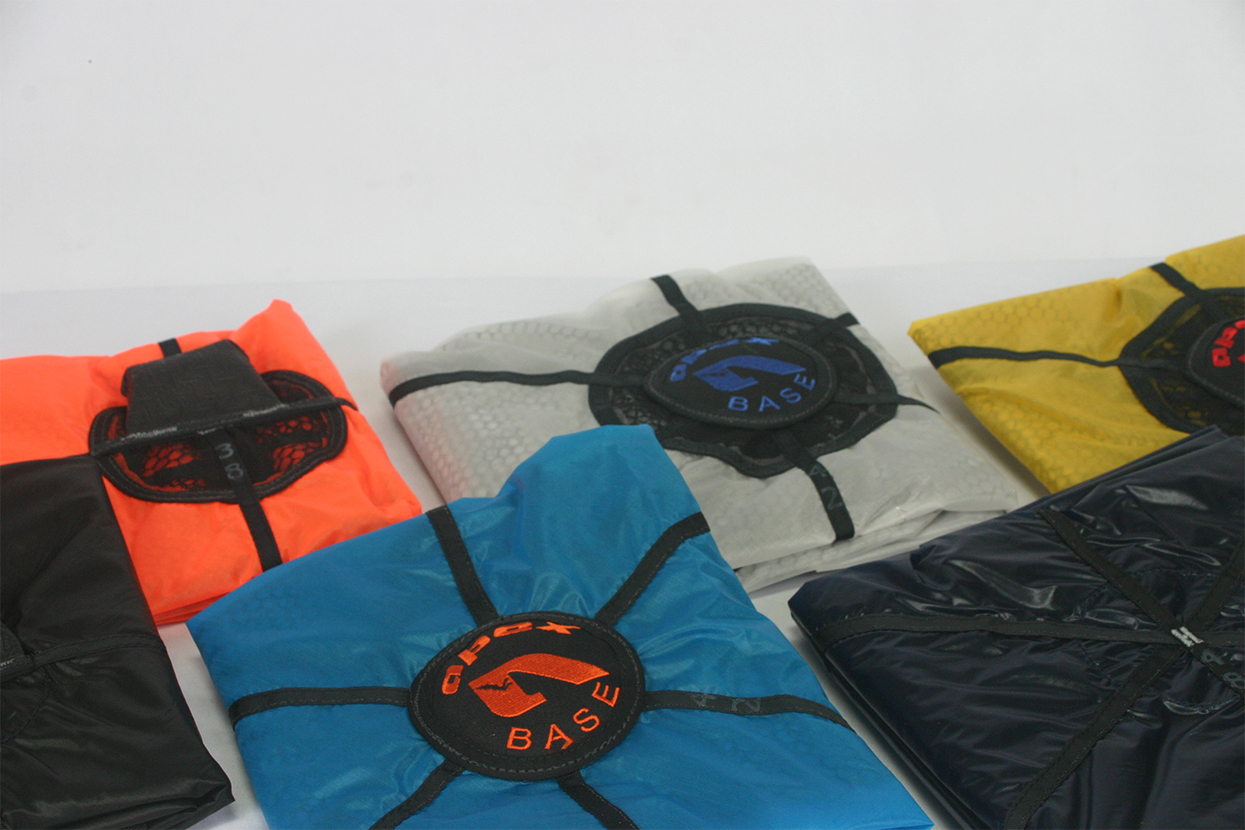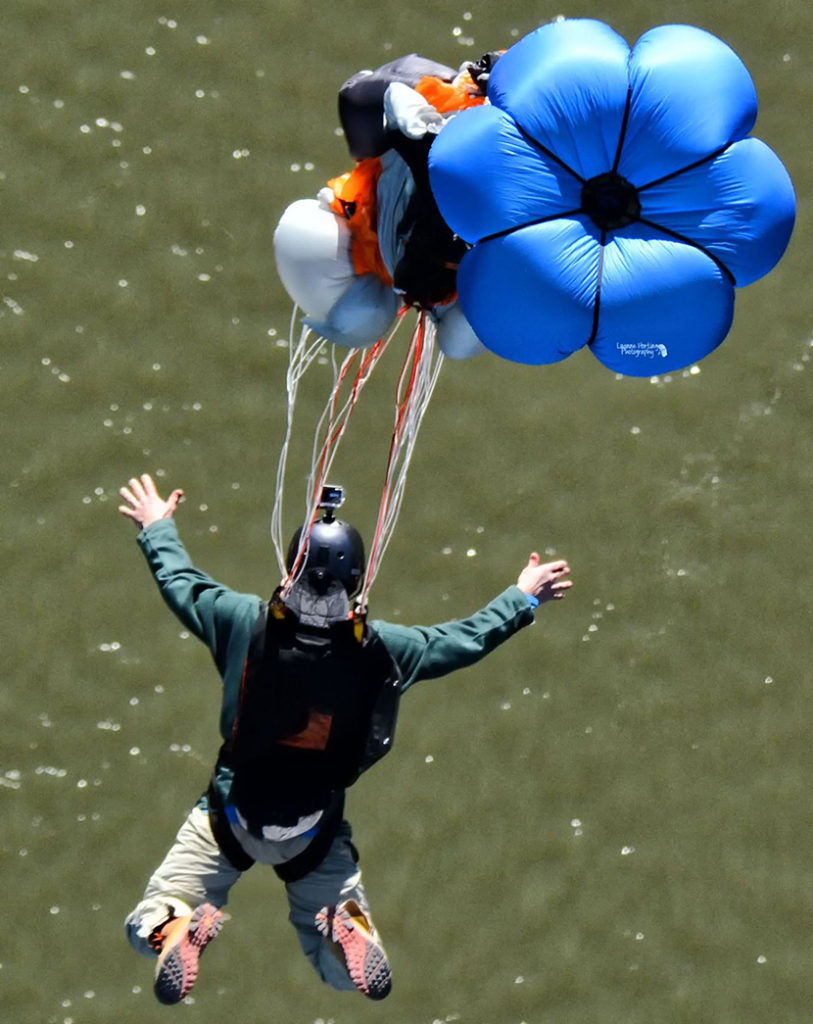Which PC do you use for a 325 foot object, and is it safe to use the same PC on a low static-line exit? Choosing the right PC for the job has become more complex as canopy designs evolved to include UltraLite and “Lite” models. The old PC matrix may not be as reliable as it once was, so we decided to fill in the gaps.
BASE Pilot Chutes come in a variety of sizes, materials, and configurations. The PC you choose for each jump should be carefully selected for that specific task while being mindful of a few different variables. This article will help walk you through the PC selection process.
Please be aware that this article is only a general guide, and every jumper should seek out proper instruction and training before attempting to BASE jump.

BASE PCs come in a variety of designs and sizes.
THE PRIMARY FACTOR IN PC SELECTION IS AIRSPEED AT DEPLOYMENT.
There are other factors of course, but airspeed at deployment is consideration number one on every jump. Generally speaking the higher the airspeed, the less PC drag will be required to efficiently and cleanly extract your canopy. What are some ways you can reduce PC drag?
1. Reduce PC size.
2. Add PC vent(s).
3. Use permeable fabric. In this case, we’re referring to 0-3 cfm (F-111) fabric instead of zero-porosity (ZP).
On a very high airspeed deployment, like on a terminal tracking jump, you should opt for a smaller PC. Adding vents and/or using porous fabric will further help to soften the opening and stabilize the PC during extraction.
On a very low airspeed deployment though (like a go-and-throw from a low object) you’ll want to do the opposite and increase PC drag to get your canopy extracted as quickly as possible:
1. Increase PC size.
2. Consider using non-vented designs.
3. Use ZP fabric.
The rule used to be: the longer your delay, the higher your airspeed. This simple rule has fallen out of favor in recent years as wingsuits and large-surface tracking suits have become popular in BASE. When flying these suits the jumper has the ability to control airspeed more actively and prepare for PC extraction and canopy deployment accordingly. Oftentimes you’ll see jumpers in wingsuits and large tracking suits choosing to upsize their PC to account for lower airspeeds at deployment following a “flare.” Remember: a longer delay does not ALWAYS mean a higher airspeed!
TO VENT, OR NOT TO VENT?
The primary purpose of PC vents is to reduce PC oscillation during extraction. Oscillation becomes more of an issue as airspeed increases. At low airspeeds oscillation will be relatively low regardless of the type of PC used.

Vents at the apex of the PC help stabilize the PC, reducing oscillation and promoting a clean extraction of your parachute.
With that in mind, we view vents as being counterproductive at low airspeeds. There is very little PC oscillation and the reduced drag from the vent is undesirable. PC stability becomes more at-risk with increasing airspeed. Increased airspeed usually affords jumpers the margin to reduce PC drag in exchange for PC stability. This is desirable when altitude allows.
Apex BASE PCs are never vented in the following sizes, to provide maximum drag at low airspeeds: 46”, 48”, 52”.
Apex BASE PCs have an optional vent on 40″ and 42” designs. The non-vented versions are advised for lower airspeeds, and the vented PCs are advised for longer delays and higher airspeeds on sub-terminal objects.
All Apex BASE PCs 38” and below are vented for maximum stability at high airspeeds.
PC FABRIC SELECTION
PCs 40” and larger are only available in ZP fabric for maximum drag and quick openings on low altitude jumps. 36” and 38” PCs are offered in ZP or F-111 fabric, to give jumpers more options to dial in their ideal deployment characteristics.
ZP offers more drag, and generally faster canopy extraction. An F-111 PC in the same size will produce less drag and generally softer openings. Never forget that a softer opening also usually means an opening that occurs over more altitude. If you want softer openings, you should also be prepared to pull higher.
CANOPY SIZE AND WEIGHT
Heavier canopies will require more drag, all else being equal, to extract at the same speed as a lighter canopy. Jumpers with canopies that weigh more due to size or fabric should consider upsizing their PC when compared to their counterparts. Conversely, smaller and/or UltraLite canopy pilots should consider downsizing to soften their openings.
OTHER FACTORS
There are other factors that will impact your PC selection. Every jump is different and your PC selection should always be carefully considered. Things like elevation and distance to your landing area are examples of other variables that should not be forgotten!
PC SELECTION GUIDELINES (Standard Weight, “F-111” Canopies)
Object height: Under 300 feet, static-line or PCA deployment, Slider-off:
-Canopy size 180 – 210: 42” ZP, non-vented
-Canopy size 220 – 260: 46” ZP, non-vented
-Canopy size 270 – 310: 48” ZP, non-vented
-If the S/L or PCA deployment goes as planned the PC should not come into play. It is used purely as an “emergency brake” if the S/L fails, or PCA is dropped. In this emergency situation you’ll want all the PC drag you can get without making the PC so large as to be inappropriate for your canopy during flight. We do not recommend ever jumping a packed BASE rig without a PC securely attached to your bridle.
Object height: Approx. 300+ feet, delay 0-1.5 Seconds, Slider-off:
-Canopy size 180 – 210: 40” ZP, non-vented
-Canopy size 220 – 260: 42” ZP, non-vented
-Canopy size 270 – 310: 46” ZP, non-vented
Object height: Approx. 350+ feet, delay 1.6-2.5 seconds, Slider-off:
-Canopy size 180 – 210: 40” ZP, non-vented
-Canopy size 220 – 260: 42” ZP, non-vented
-Canopy size 270 – 310: 46” ZP, non-vented
Object height: Approx. 450+ feet, delay 2.6-3.5 seconds, Slider-off:
-Canopy size 180 – 210: 40” ZP, vented
-Canopy size 220 – 260: 42” ZP, vented
-Canopy size 270 – 310: 42” ZP, vented
Slider-off delays longer than 3.5 seconds are not recommended. People take them, but it’s hard on your equipment, hard on your body, and hard for us to watch!
Object height: 600-1000 feet, sub-terminal slider-up:
-Canopy size 180 – 210: 36” ZP, vented; large mesh slider
-Canopy size 220 – 260: 38” ZP, vented; large mesh slider
-Canopy size 270 – 310: 38” or 40” ZP, vented; large mesh slider
Object height: 1000+ feet, terminal slider-up (all canopy sizes):
-Slick, tracking suit (2-piece): 36” or 38” ZP or F-111, vented; small mesh or slow slider.*
-WS or large surface TS: 36” or 38” ZP or F-111, vented; small mesh or slow slider.*
*All variables dependent on suit size and planned deployment airspeed.
PC SELECTION GUIDELINES (UltraLite & “Lite” Canopies)
Object height: Under 300 feet, static-line or PCA deployment, Slider-off:
-Canopy size 180 – 210: 40” ZP, non-vented
-Canopy size 220 – 260: 42” ZP, non-vented
-Canopy size 270 – 310: 46” ZP, non-vented
-If the S/L or PCA deployment goes as planned the PC should not come into play. It is used purely as an “emergency brake” if the S/L fails, or PCA is dropped. In this emergency situation you’ll want all the PC drag you can get, without making the PC so large as to be inappropriate for your canopy during flight. We do not recommend ever jumping a packed BASE rig without a PC securely attached to your bridle.
Object height: Approx. 300+ feet, delay 0-1.5 Seconds, Slider-off:
-Canopy size 180 – 210: 40” ZP, non-vented
-Canopy size 220 – 260: 42” ZP, non-vented
-Canopy size 270 – 310: 46” ZP, non-vented
Object height: Approx. 350+ feet, delay 1.6-2.5 seconds, Slider-off:
-Canopy size 180 – 210: 40” ZP, non-vented
-Canopy size 220 – 260: 42” ZP, non-vented
-Canopy size 270 – 310: 42” or 46” ZP, non-vented
Object height: Approx. 450+ feet, delay 2.6-3.5 seconds, Slider-off:
-Canopy size 180 – 210: 40” ZP, vented
-Canopy size 220 – 260: 40” or 42” ZP, vented
-Canopy size 270 – 310: 42” ZP, vented
Slider-off delays longer than 3.5 seconds are not recommended. People take them, but it’s hard on your equipment, hard on your body, and hard for us to watch!
Object height: 600-1000 feet, sub-terminal slider-up:
-Canopy size 180 – 210: 36” ZP or F-111, vented; large mesh slider
-Canopy size 220 – 260: 38” ZP, vented; large mesh slider
-Canopy size 270 – 310: 38” or 40” ZP, vented; large mesh slider
Object height: 1000+ feet, terminal slider-up (all canopy sizes):
-Slick, tracking suit (2-piece): 36” or 38” ZP or F-111, vented; small mesh or slow slider.*
-WS or large surface TS: 36” or 38” ZP or F-111, vented; small mesh or slow slider.*
*All variables dependent on suit size and planned deployment airspeed.
